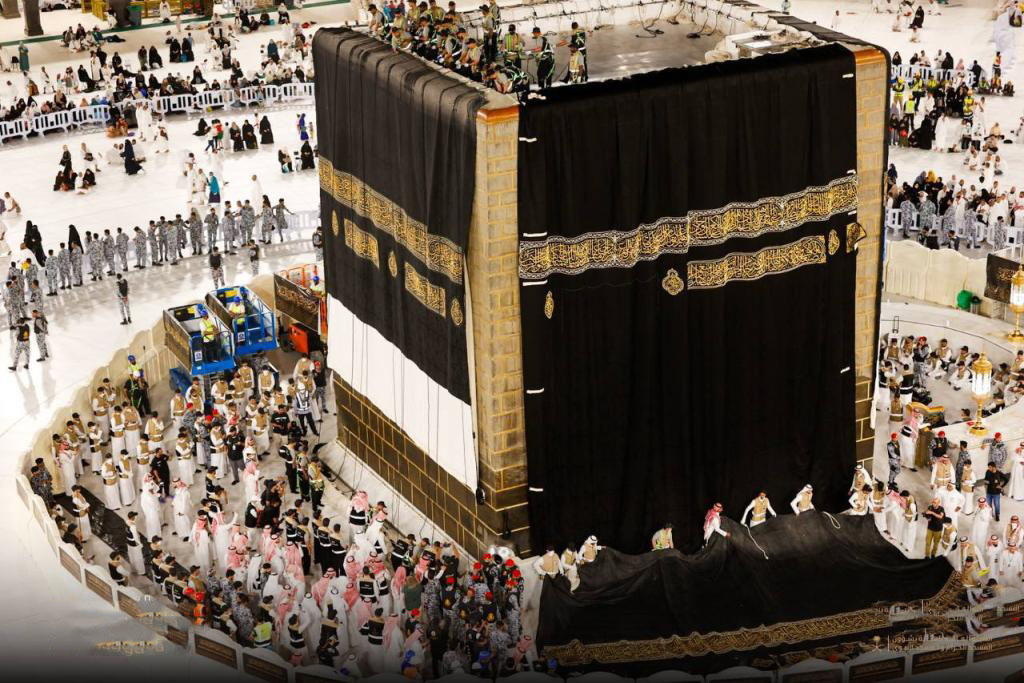The Kiswah of the Ka’bah

The Kingdom of Saudi Arabia, under the leadership of the Custodian of the Two Holy Mosques, King Salman ibn ‘Abdul-‘Aziz Al Saud, has consistently paid special attention to the Two Holy Mosques, their visitors, and the K’abah. The Kingdom has provided the latest equipment and machines for manufacturing and sewing the K’abah’s covering (Kiswah) to the highest of standards.
One of the most notable advancements during this prosperous era is the providing of the “Tajima” and “Jacquard” machines, which are used to create the K’abah’s Kiswah adorned with inscriptions of supplications, golden lanterns, and words. This process is carried out by a specialized technical team of trained and qualified national hands on these machines, which contain more than 9,000 silk threads. The modern sewing machine works on the warp threads for the K’abah’s cover in the automated weaving section, using advanced technical methods. The machine is equipped with twelve heads, each working on winding a bobbin for one warp.
Since the era of the founder, King ‘Abdul-‘Aziz Al Saud, the craft of making the K’abah’s cover has received care and attention. A dedicated factory was established in the Ajyad neighbourhood in front of the Ministry of Finance in Makkah in 1346 AH. This was the first Saudi-made cover created in Makkah.
His sons continued to take care and develop the Kiswah, completing the first cover made in the new factory after three months, specifically in August 1962. The Kiswah bore the inscription: “This cover was made in Makkah and was gifted to the K’abah by the Custodian of the Two Holy Mosques Saud ibn ‘Abdul-‘Aziz al-Saud. May Allah accept it. Year 1381 AH.”
In 1962, King Saud bin ‘Abdul-‘Aziz ordered the establishment of the Kiswah factory and entrusted this task to his brother King Faisal, who assigned the Minister of Hajj and Endowments, Hussein Arab, to choose a building belonging to the Ministry of Finance in Jarwal (a neighbourhood in Makkah).
This care continued during the reigns of King Faisal bin ‘Abdul-‘Aziz, King Khalid, and King Fahd, where the Kiswa factory was moved to its new building in Umm ul-Joud in 1397 AH and equipped with the most advanced machinery in the industry. The Kiswah has since been crafted in its most beautiful forms.
The Custodian of the Two Holy Mosques, King ‘Abdullah ibn ‘Abdul-‘Aziz al-Saud, approved the modernisation and replacement of the electronic systems, electrical devices, and mechanical equipment in the Kiswah factory to match the newly developed systems, marking an advanced developmental leap in the field of making the K’abah’s cover.
In honour of the founding king, the Custodian of the Two Holy Mosques, King Salman bin ‘Abdul-‘Aziz al-Saud, approved the renaming of the Kiswah factory to the King Abdul-Aziz Complex for the Holy K’abah Kiswah on Tuesday, 13/08/1439 AH.
This highlights the Kingdom of Saudi Arabia’s special care for the K’abah’s Kiswah since its beginning, reaching the prosperous era of the Custodian of the Two Holy Mosques, King Salman bin ‘Abdul-’Aziz Al Saud, where all technical capabilities and human resources have been provided to serve the House of Allah.